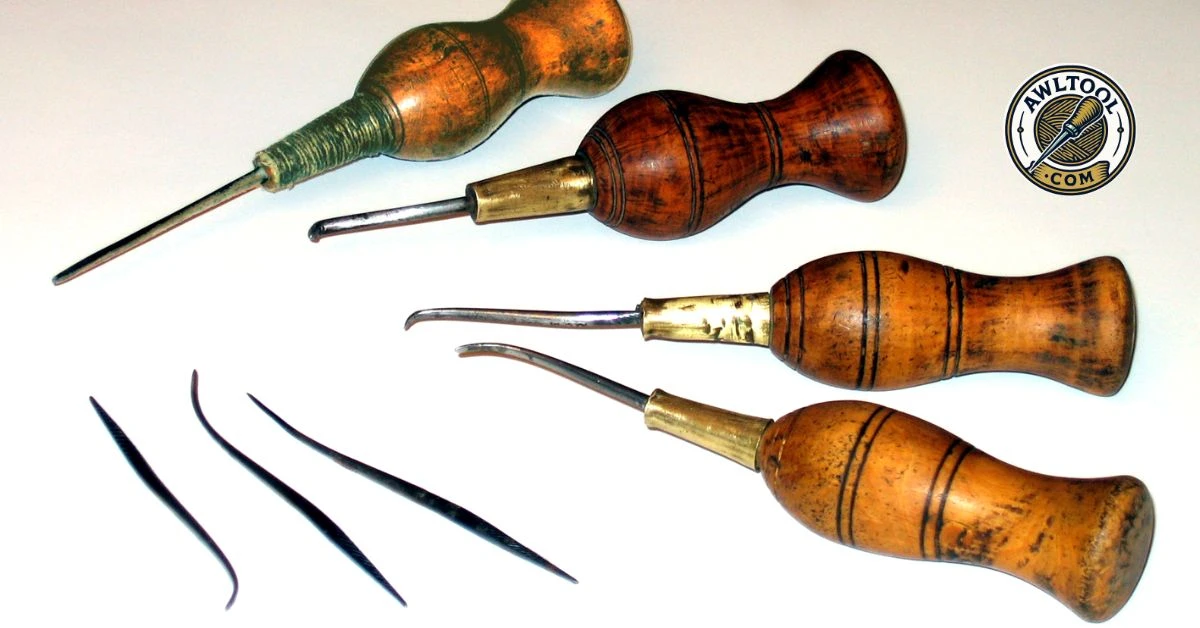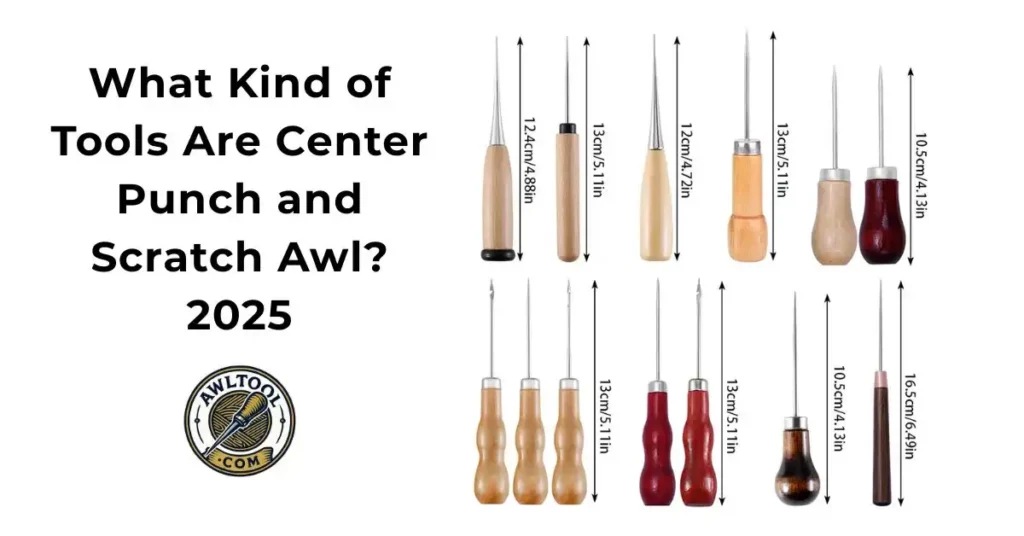Have you ever seen someone use a sharp tool to poke holes in leather, wood, or even paper? That tool is called an awl, and the people who use it do some very precise and skilled work. So, what’s the job of a worker who uses an awl?
A worker who uses an awl is typically involved in leatherworking, woodworking, bookbinding, sewing, upholstery, or even survival crafts. The awl helps them pierce holes, mark materials, and perform accurate, hand-crafted tasks that machines often can’t replicate.
This article explores What Is the Job of the Worker Who Uses a Tool Called an Awl? what types of professionals use it, and how its function varies depending on the job.
📱 Join the conversation on Facebook: Share your favorite marking or drilling tools and tag us to get featured!
Table of Contents
What Is an Awl?

An awl is a sharp, pointed hand tool with a sturdy handle, used to pierce, mark, or enlarge holes in various materials like leather, fabric, wood, or metal. It allows for high precision in manual work. The shape and type of an awl vary based on the industry—from flat awls for stitching to curved awls for upholstery.
📌 Fact: Over 90% of traditional leatherworkers consider an awl a must-have tool in their toolkit.
What Is the Purpose of an Awl?
The main purpose of an awl is to:
- Pierce tough materials without tearing them
- Mark measurements or patterns on wood, leather, or fabric
- Guide stitches in hand-sewing or bookbinding
- Create pilot holes for screws or threads
- Enable precision that power tools can’t offer
Awls are essential for accuracy, control, and detail work in many manual trades.
They are especially important in traditional trades across the United States where craftsmanship, hand-stitching, and tailored construction still matter.
Who Uses an Awl Tool? Key Job Roles in the USA
Awls are used by a wide variety of professionals and hobbyists in the USA. These include:
1. Leatherworkers & Shoemakers
Leatherworkers use awls daily to:
- Mark stitching lines
- Punch holes for threads, rivets, and snaps
- Stitch leather by hand with a threaded sewing awl
👢 Shoemakers (cobblers) rely on awls for shaping and reinforcing soles, uppers, and decorative lacing. Many U.S.-based shoemakers—especially those in custom boot making hubs like Texas and New Mexico depend on awls for traditional craftsmanship.
Check video – Leather Working Awls
📌 Tip: See our guide on the Best Awl Sets for Leatherworking
2. Woodworkers & Carpenters
Woodworking often requires precision layout work:
- Scratch awls mark exact cutting or drilling points
- Bradawls create pilot holes in hardwood
- Curved awls can trace grain patterns
📊 Fact: 8 out of 10 traditional furniture makers prefer bradawls over electric drills for fine layout work.
From Pennsylvania Dutch woodshops to California custom cabinet makers, awls remain vital.
3. Bookbinders
Bookbinding is one of the oldest and most detailed professions using awls:
- Piercing signatures (groups of pages)
- Aligning sewing stations
- Preventing paper from tearing during binding
📘 Used in both antique book restoration and hand-bound art books.
✅ Bookbinders love awls for their control, especially with layered paper and thread.
4. Metalworkers & Craft Hobbyists
Though not common in heavy machining, awls are used for:
- Scribing metal surfaces
- Marking drill points
- Assisting with layout in jewelry making or model crafting
🔧 Metalworkers often choose center punches, but awls help in marking and surface scoring.
DIY metal artists across the U.S., especially on platforms like Etsy, use awls for clean designs.
5. Tailors, Seamstresses & Upholsterers
In tailoring, fashion design, and upholstery, awls help with:
- Piercing thick fabric or leather
- Guiding hand-sewn seams
- Applying rivets and hardware
🪡 A threaded awl lets seamstresses sew thick canvas or leather when a machine isn’t strong enough.
📍 Many small upholstery shops in states like North Carolina and Illinois rely on awls for detailed manual repairs.
🔗 Explore more: What Is The Main Purpose Of An Awl? 10 Practical Uses for New Mexicans
6. Survivalists, Outdoor Enthusiasts & Multi-Tool Users
Awls in multi-tools are incredibly helpful for outdoorsmen:
- Repairing gear and clothing
- Creating fire-starters with bow drills
- Punching holes in plastic or canvas
- Carving or trapping applications
🔥 Fact: Over 60% of military-issued multi-tools in the US include an awl attachment.
Popular among bush crafters, campers, and survivalists in areas like Colorado and Montana.
Types of Awl Tools (Brief Overview)
- Scratch Awl – for marking wood or leather
- Stitching Awl – includes thread, ideal for leather sewing
- Bradawl – used in woodworking to make pilot holes
- Saddler’s Awl – extra strong for saddlery or thick hide
- Curved Awl – reaches around or into corners
- Sewing Awl – includes spool, needle, and thread
👉 For full details, check out our Types of Awl Tools Guidelines.
Tools Similar to an Awl
| Tool | Used For | Difference From Awl |
| Center Punch | Marking metal for drilling | Heavier and hammer-driven |
| Nail Set | Driving nail heads below wood surface | Blunt tip, not piercing |
| Scribe | Drawing lines on metal surfaces | More refined marking tool |
| Ice Pick | Piercing ice or food items | Kitchen/survival use |
📌 Awl vs Center Punch is a common debate—read our breakdown for more clarity.
10 Real-Life Awl Uses You Might Not Know
- Punching holes in belts or straps
- Marking woodworking joints before sawing
- Repairing torn leather bags or gear
- Making starter holes for screws
- Hand-sewing tents and tarps
- Lacing boots, saddles, or corsets
- Piercing pages for bookbinding
- Starting fires with a bow drill kit
- Fixing backpack straps or survival kits
- Making holes in garden irrigation pipes
Historical and Cultural Significance
The awl has played a vital role in human history and the evolution of crafts across many civilizations.
Prehistoric Origins
- Awls made from bone and stone were used as early as 120,000–90,000 years ago, according to ASU News.
- Early humans used them to make holes in hides for clothing, create woven items, and build shelters.
Ancient Egypt & the Middle East
- Awls made of copper have been discovered in tombs, showing their use in textile and leatherworking.
- The oldest known metal object in the Middle East is a copper awl found in a 7,000-year-old Israeli tomb.
Indigenous & Colonial America
- Native American tribes used bone awls for beadwork, basketry, and clothing.
- In Colonial America, awls were used by shoemakers, tailors, and saddlers to pierce leather and cloth.
Industrial Revolution
- Even with the rise of factories, hand-held awls remained essential for precision in leather, textile, and bookbinding trades.
Cultural Impact of Leather
- Awls contributed to leather’s cultural value—from military gear to cowboy boots.
- In the USA, states like New Mexico and Texas have long traditions of leathercraft where the awl remains iconic.
Archaeological evidence shows awls were among the earliest tools shaping clothing, identity, and survival.
Frequently Asked Questions (FAQs)
What are the most common awl types in the USA?
- Stitching awl (leatherwork)
- Bradawl (woodworking)
- Scratch awl (general-purpose marking)
What materials can you use an awl on?
Leather, canvas, plastic, cardboard, wood, fabric, book paper, and even thin metal.
What makes an awl different from a punch?
An awl pierces the material without removing any part of it. A punch removes a small piece, often using force with a hammer.
Conclusion: What Is the Job of the Worker Who Uses a Tool Called an Awl?
The job of someone who uses an awl varies from crafting boots to building books, but they all rely on the awl’s unmatched precision. Whether you’re into woodworking, leatherworking, tailoring, metalworking, crafting, or bookbinding, the awl remains a simple but powerful hand tool.
It offers control, tradition, and hand-made quality that machines can’t replace.
📚 Want to explore more? Check out:
- What Kind of Tools Are Center Punch and Scratch Awl?
- 20+ Best Awl Tools in 2025
- Top Awl Tool Shops in New Mexico
AwlTool.com – Your Go-To Guide for Awl Tools in the USA

Hi, I’m Nicholas N. Goforth, a New Mexico crafter with 20 years of experience in leatherworking, woodworking, and bookbinding.
Inspired by a Santa Fe market, I turned my passion into AwlTool.com, launched in 2025, to share tutorials and handcrafted goods.



